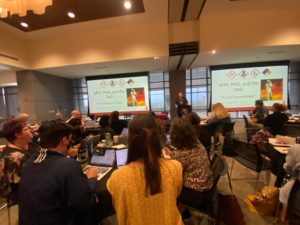
What is PFAS?
Per-and Polyfluoroalkyl Substances (PFAS) consist of a group of synthetic chemicals. The National Institute of Environmental Health Sciences (NIH) states, according to a chemical database (CompTox) maintained by the U.S. Environmental Protection Agency (EPA), over 15,000 variations of PFAS exist today.
While the chemistry of PFAS has existed since the 1930s, consumer products have been manufactured with some type of PFAS since the 1950s. The Agency for Toxic Substances and Disease Registry (ATSDR) states, “Most people in the United States have been exposed to PFAS and have PFAS in their blood.”
Routes of Exposure

The most common routes of exposure include ingestion, absorption, and inhalation. It is estimated that approximately 110 million Americans have been exposed to PFAS through the use of consumer products manufactured with some type of PFAS or exposure to things containing PFAS. Some examples may include:
- Non-stick cookware
- Waterproof/resistant clothing, carpeting, and fabrics used in furniture
- Firefighting foam
- Firefighter protective ensembles known as turnout gear
- Personal care products such as cosmetics, dental floss, shampoo
- Food Packaging such as fast-food wrappers, pizza boxes, microwave popcorn bags
- Biosolids such as fertilizers
- Artificial turf
- Components used in electronics such as mobile phones
- Sealants and adhesives to include caulking
- Certain building materials to include composites
- Contaminated drinking water
- Contaminated wildlife, aquatic species, vegetation
- Leachate from unlined landfill sites
- Dust
Occupational Exposure

The Occupational Safety and Health Administration (OSHA) defines occupational exposure as, “Reasonably anticipated skin, eye, mucous membrane, or parenteral contact with blood or other potentially infectious materials that may result from performance of an employee’s duties.” OSHA has not set any legal limits for PFAS.
The National Fire Protection Association (NFPA) defines occupational exposure as, “An infectious exposure that resulted from performance of a member’s duties.
While PFAS is not considered an infectious material, it is considered toxic. The National Institute of Occupational Safety and Health (NIOSH) has not set any recommended limits for PFAS in air.
Aside from daily exposure to consumer products, firefighters are exposed to PFAS by way of products of combustion. Considering the amount of consumer products found in our homes that contain PFAS, when consumed by fire or exposed to high temperatures, those products emit toxic gasses, fumes, soot, ash, or smoke that is inhaled and or absorbed by those exposed to such. Those products of combustion easily attach themselves to the firefighter’s protective ensembles and exposed skin. Until the products of combustion are thoroughly removed, the firefighter will be continuously exposed, thereby increasing their risk of developing potential health effects.
PFAS Health Effects

Because PFAS are synthetic chemicals, they do not naturally occur, neither in the environment or our bodies. Therefore, when these foreign substances enter with our bodies, they may perturb or cause certain components to react. Some examples are:
- Increases in cholesterol levels
- Changes in liver enzymes
- Decreases in child birth weight
- Lower antibody responses to vaccines
- Pregnancy induced hypertension and preeclampsia
- Kidney and testicular cancer
PFAS Blood Testing

Despite the long history of PFAS in manufacturing, most consumers were unaware of their existence until recently, the last decade or so. Testing blood for PFAS is relatively new and is a means of determining exposure. While there are many laboratories conducting blood testing, not all test the same. In fact, not all laboratories test the same, therefore the results may vary from one laboratory to the next.
Eurofins, considered innovative leaders in food, environment, pharmaceutical and cosmetic product testing, developed a remote sampling blood testing kit that allows individuals to provide a sample from their home or work in a matter of minutes.
Admittedly, receiving a positive result does not automatically mean you will become ill such as develop some type of related disease or cancer. Rather a blood test result is simply a baseline to measure the amount of PFAS in your blood and assist you and your physician to monitor levels in the future; the goal is to decrease the amount detected.
We highly recommend that after you have your blood tested, you meet with your healthcare provider to discuss the results. Because PFAS is relatively new in the medical community, it may be likely your physician has limited knowledge on PFAS and associated health effects. If that is the case, please feel free to reach out to AFSO21 and ask questions. Our tailored fire emergency services advisory support can help your local responders with reducing risk of occupational exposure to PFAS and contamination to the community they serve. Click the button below to contact us today:
Managing Occupational Exposure to PFAS

Don’t miss this critical presentation on PFAS exposure! Hear from one of America’s most outspoken advocates for preventing firefighter occupational exposure to PFAS and how you can protect yourself and your organization from the hidden dangers of toxic “forever chemicals”.
2025 U.S. Fire Service PFAS Exposure Survey

The FY2020 National Defense Authorization Act (NDAA) mandated the United States Department of Defense (DoD) offer PFAS blood tests to all DoD firefighters. In 2021, after an in-depth evaluation of the PFAS blood testing program, the Department of Defense Inspector General (DoDIG) found the DoD was not tracking, trending, or analyzing PFAS blood test data. Upon learning of this, AFSO21 immediately created a survey to determine what, if any, PFAS compounds DoD firefighters were exposed to. The results were alarming.
Previous surveys conducted by AFSO21 indicated that most survey participants had detectable levels of PFAS in their blood to include elevated levels of PFOA and PFOS. Approximately 96% of survey participants reported levels of PFHxS exceeding the CDC / NHANES Study’s Geometric Mean of 1.08 ng/mL (1,080 ppt). PFHxS is a lesser known PFAS chemical that is used to replace PFOA, a compound typically used and found in firefighter turnout gear and fluorinated firefighting foams, as well as other products.
AFSO21 is conducting the 2025 survey to further gather information about firefighter’s exposure to PFAS. Your participation will help raise awareness, advocate for change, and protect the health and safety of firefighters around the world.
Please take a moment to conduct this survey; your input is crucial.